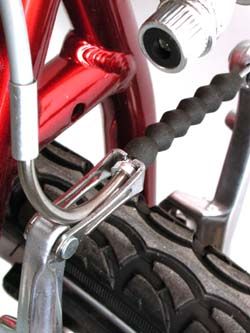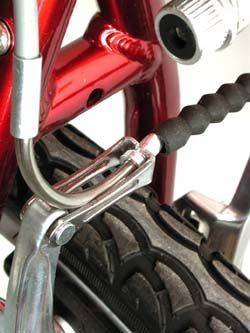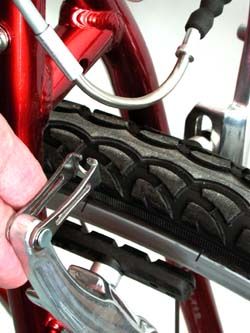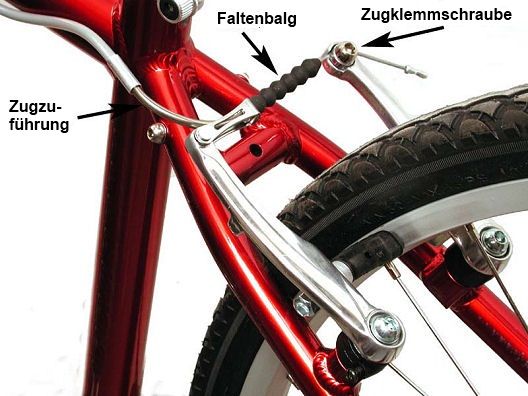Einstellen von Direktzugbremsen: Unterschied zwischen den Versionen
K (→Schnellverschluss: abgestuft) |
(→Parallelogramm Koppelung: übersetzt) |
||
| Zeile 32: | Zeile 32: | ||
'''Wenn Du das Laufrad wieder einbaust, denke unbedingt daran, dass Du die Bremse wieder einhängst!''' | '''Wenn Du das Laufrad wieder einbaust, denke unbedingt daran, dass Du die Bremse wieder einhängst!''' | ||
==Parallelogramm Koppelung== | ===Parallelogramm Koppelung=== | ||
[[Image:Xtr-vbrake.gif|right|thumb|Shimano XTR Bremse mit Paralleogramm Koppelung]] | |||
Shimanos [[XTR]] und [[XT]] V-Brakes haben eine spezielle Parallelogramm Koppelung. Diese dient zwei Zwecken: | |||
* Der Bremsschuh bleibt während der Bewegung und der Lebensdauer des Bremsbelags immer im gleichen Winkel zur Felge ausgerichtet | |||
* Die Bewegunsgausführung des Bremsschuhs bleibt nahezu horizontal statt des - wie bei anderen Modellen - leichten Bogens, dessen Zentrum im Bremssockel liegt. Das ist ein Vorteil inbesondere für Fahrer besonders breiter Reifen auf schmalen Felgen. Dies verhindert, dass der Bremsschuh auftsiegt und die Seitenwand des Reifens beschädigt. Auch wird verhindert, dass der Bremsshuh unter der felge hindurchtauchen kann, wenn der Belag verschleißt. | |||
Unglücklicherweise verkmplizieren die zusätzlichen Gelenke den Mechanismus. Das hat häufig Wartungsproblemen zur Folge und kann zu exzessivem Quietschen der Bremse führen. | |||
==Einstellen der Direktzugbremse== | ==Einstellen der Direktzugbremse== | ||
Version vom 9. Januar 2013, 13:50 Uhr
Direktzugebremsen sind eine Abwandlung der Cantileverbremse. Bei Shimano sind sie mit dem Markennamen V-Brake ® geführt.
In Zusammenhang mit diesem Artikel solltest Du unbedingt auch Das 1x1 der Felgenbremsen lesen. Die meisten Probleme bei Felgenbremsen resultieren aus zu hoher Reibung bzw. schlechter Montage der Züge und gerade nicht aus schlechter Bremseneinstellung oder billigen Bremsen.
- Siehe auch
Direktzugbremsen im Vergleich zu klassischen Cantilever Bremsen
Klassische Cantilever Bremsen haben zwei Züge. Der eine ist der Hauptzug, der an der Mitte des Fahrrads entlang verläuft und der zweite Zug ist der Querzug, der die beiden Ausleger auf beiden Seiten des Reifens miteinander verbindet. Der Hauptzug zieht an der Mitte des Querzugs nach oben und so werden die Ausleger nach Innen rotiert.
Direktzugbremsen - auch geläufiger unter der Shimanomarke "V-Brake" bekannt - sind in ihrem Aufbau einfacher, weil sie nur einen Zug benutzen. Die Zughülle ist mit einem Arm verbunden und der innenliegende Zug verläuft ohne Hülle über den Reifen hinweg zum gegenüberliegenden Arm. Wenn die Bremse betätigt wird, drückt die Zughülle gegen den einen Ausleger während der Innenzug am gegenüberliegenden Ausleger zieht.
Da der Zug direkt oberhalb des Reifens verläuft, benötigen Direktzugbremsen längere Bremsarme, damit der Zug hoch genug über den Reifen verläuft, um Kontakt zu vermeiden. Das erhöht die Hebelübersetzung des Systems, so dass speziell passende Bremshebel benötigt werden.
Schnellverschluss
Um das Laufrad ausbauen zu können, wird die Zugzuführung aus der Bindung ausgehakt. Dadurch können sich die Bremsschuhe so weit auseinander bewegen, dass sogar ein dicker Reifen hindurchpasst.
Zum Öffnen, ziehst Du zuerst den Faltenbalg vom Ende der Zugzuführung. Dann drückst Du die Bremsarme mit einer Hand zusammen und hakst mit der anderen Hand das Ende der Zugzuführung aus dem schlüssellochähnlichen Schlitz der Bindung aus.

|

|

|
| V-Brake in normaler geschlossener Position | V-Brake mit zurückgeschobenem Faltenbalg | V-Brake mit ausgehänger Zugzuführung |
Wenn Du das Laufrad wieder einbaust, denke unbedingt daran, dass Du die Bremse wieder einhängst!
Parallelogramm Koppelung
Shimanos XTR und XT V-Brakes haben eine spezielle Parallelogramm Koppelung. Diese dient zwei Zwecken:
- Der Bremsschuh bleibt während der Bewegung und der Lebensdauer des Bremsbelags immer im gleichen Winkel zur Felge ausgerichtet
- Die Bewegunsgausführung des Bremsschuhs bleibt nahezu horizontal statt des - wie bei anderen Modellen - leichten Bogens, dessen Zentrum im Bremssockel liegt. Das ist ein Vorteil inbesondere für Fahrer besonders breiter Reifen auf schmalen Felgen. Dies verhindert, dass der Bremsschuh auftsiegt und die Seitenwand des Reifens beschädigt. Auch wird verhindert, dass der Bremsshuh unter der felge hindurchtauchen kann, wenn der Belag verschleißt.
Unglücklicherweise verkmplizieren die zusätzlichen Gelenke den Mechanismus. Das hat häufig Wartungsproblemen zur Folge und kann zu exzessivem Quietschen der Bremse führen.
Einstellen der Direktzugbremse
First, remove the arms from the studs, and make sure the studs are free of rust. Coat the studs liberally with grease (this is VERY important!)
Install the arms with them at their maximum spread and tighten the bolts that hold them to the frame. This is how you set the springs.
Shoe adjustment is covered in the article about rim brakes, but there are a few special things about direct-pull brakes:
- Most direct-pull brakes use smooth-stud type brake shoes, which allow adjustment of extension -- that is, how far the shoe is inboard of the brake arm.
- The brake shoes only need to be extended inward from the brake arms if the brake arms are too close together at the top, interfering with the tire or allowing too little cable travel.
- If your brakes use the Parallel-Push linkage, the pivots may need servicing. There are special kits for this.
Mittig ausrichten
When the brake is released, the brake shoes retract away from the rim. Ideally, the shoes on both sides should back off by the same amount. If they don't, the brake is not properly centered. In extreme cases, one of the shoes may not retract, and may rub on the rim even when the brake is not being applied.
If a brake appears off-center, check first that the wheel is installed straight in the frame/fork. If the wheel is crooked, and you maladjust the brake to compensate, you are creating two problems where there was only one before.
Einstellen der Vorspannung
If your wheels are centered, and your brakes are not, and, if the pivots are properly lubricated and free-moving, the brake shoes should be centered. If they are not, you probably need to adjust the spring tension on one or both of the cantilevers.
Most direct-pull cantilevers have adjustable spring tension. The adjustment will be a small screw with the head facing outward to the side of the bike. The screw is generally located near the bottom of the cantilever, below the pivot point. Sometimes it works with a Phillips screwdriver; other times, a small Allen wrench may be needed.
DESCRIPTION Tightening this screw tightens the spring, so you want to tighten the spring of whichever arm is too close to the rim. This will make it spring back farther.
Bremshebel für Direktzugbremsen
Direct-pull cantilevers have double the mechanical advantage compared with traditional brakes, so they require special brake levers. Direct-pull brake levers pull the cable twice as far, half as hard. The lower mechanical advantage of the lever compensates for the higher mechanical advantage. of the cantilever. It is not generally safe to mix and match levers/cables between direct-pull and other types for this reason.
- Conventional brake levers used with direct-pull cantilevers will usually not pull enough cable to stop in wet conditions without bottoming out against the handlebars. In dry conditions, they either won't work, or will grab too suddenly.
- Direct-pull brake levers used with any other type of brakes will feel nice and solid when you squeeze them, but due to their lower mechanical advantage you'll need to squeeze twice as hard to stop as you should, so unless you are a lightweight rider with gorilla-like paws, this combination isn't safe either.
Hebel für Dropbar Montage
To make a brake lever with low enough mechanical advantage for direct-pull cantilevers, the cable must run twice as far from the lever's pivot point. This is easy enough to do with levers for straight/upright handlebars. Levers for drop handlebars are harder to configure for direct-pull brakes, and currently, there are only a couple of drop-bar levers made that are compatible, the Dia Compe 287V and the Cane Creek SCR-5V "Æro" levers.
Most newer drop bar bikes are have Ergo or STI brake/shifter units as original equipment. Direct-pull cantis are not compatible with these. Other types of shifters may of course be used, along with the special brake levers. In any case many cyclists prefer bar-end shifters. These are simpler and less expensive than brake-lever shifters, and give an indication of what sprocket is in use: brake-lever shifters return to the same position after every shift.
Hilfskonstruktionen für Dropbars
If you want to use Ergo or STI brifters with direct-pull cantis, there are two workarounds available: QBP Travel Agent
- You can use a pulley-device, such as the QBP Travel Agent (Q.B.P. Photo). These are a bit of a hassle to set up, but do work. Any pulley of the small diameter commonly used on bicycles eventually leads to fatigue failure of the cable, so check the cable regularly for fraying.
- If you have a bike with skinny tires and no fenders, there are "shorty" direct-pull cantis that are more-or-less compatible with drop bar levers.
Neither of these systems is ideal, and neither is really any better than traditional center-pull cantilevers.
Kompatibilität
Hierzu findet man alles im Artikel Kompatibilität von Cantilever Bremsen (Tabelle)
Siehe auch
Quelle
Dieser Artikel basiert auf dem Artikel Adjusting Direct-pull Cantilever Bicycle Brakes ("V-Brakes ®") von der Website Sheldon Browns. Originalautor des Artikels ist Sheldon Brown.
